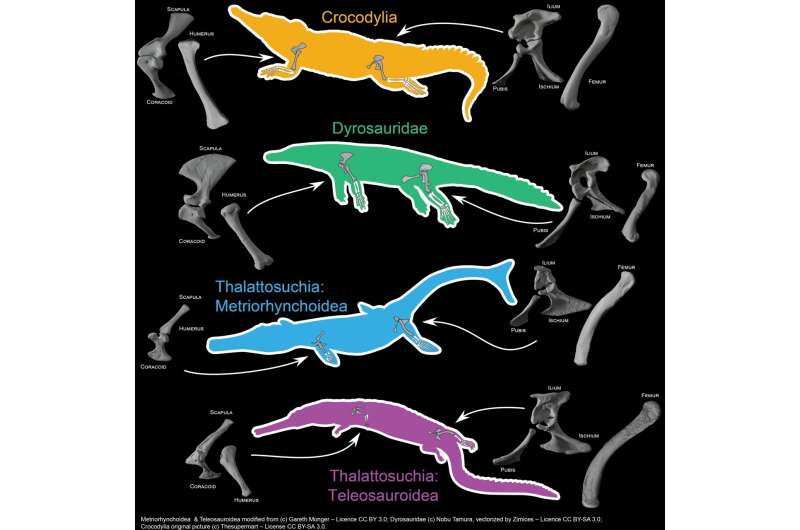This article has been reviewed according to Science X's editorial process and policies. Editors have highlighted the following attributes while ensuring the content's credibility:
fact-checked
trusted source
proofread
Tracing multiple evolutionary trajectories in aquatic crocodiles

In the geological past, several groups of crocodiles evolved towards a morphology adapted to marine life. However, the extent of these adaptations and their evolutionary trajectories remained unknown. An exhaustive study of their morphology by a scientific team from the University of Liège has now shed light on the evolutionary mechanisms at work, thanks to three-dimensional reconstructions.
Contrary to what its few current species might suggest, the crocodile group was highly diversified in the past, with herbivorous, arboreal, and even totally marine species. Thalattosuchians and dyrosaurs, two crocodile species, colonized the marine environment independently in the geological past.
"These two groups of crocodiles are also very interesting to study because they managed to survive major biological crises," explains Isaure Scavezzoni, a doctoral student at the Evolution & Diversity Dynamics Lab and principal author of the study published in Palaeontology. "Thalattosuchians survived the Jurassic-Cretaceous transition (145 million years ago) and dyrosaurs the mass extinction at the end of the Cretaceous (66 million years ago)," says Scavezzoni.
However, the extent and diversity of these animals' adaptations to marine life are still very poorly understood because their body anatomy has been relatively little studied. We do not know the evolutionary trajectories underlying these evolutionary successes. Are they similar or did these groups take different routes to marine life? Researchers at the University of Liège's EDDyLab have attempted to answer this question using 3D modeling.
"The scale of the task involved in answering these questions is immense," explains Valentin Fischer, paleontologist and director of the EDDyLab. "We have carried out hundreds of scans and high-definition 3D reconstructions of the limb, shoulder and pelvis bones of a wide range of species of thalattosuchians, dyrosaurs and even modern crocodiles."
These data enabled the team to analyze the evolutionary trajectories of these two species in order to detect possible convergences, i.e., cases of independent evolution of similar morphologies. To do this, several dozen reference points were placed on each bone; the resulting 3D coordinates were then compared between species and tested in a phylogenetic framework, taking into account the kinship links between the species analyzed.
"Our results show that thalattosuchians and dyrosaurids differ greatly from each other in their adaptations and functional capacities, but that they also diverge greatly from present-day crocodiles," says Scavezzoni.
This work reveals not only the (previously underestimated) potential of the fossil crocodile skeleton as a source of phylogenetic characters, but also that these groups differed profoundly from present-day crocodiles in the way they moved and swam. The incorporation of postcranial anatomy therefore seems crucial to fully assess the ecology, disparity, and relationships of crocodylomorphs.
More information: Isaure Scavezzoni et al, Limited convergence in the postcranium of aquatic Crocodylomorpha, Palaeontology (2023). DOI: 10.1111/pala.12678
Provided by University de Liege





















